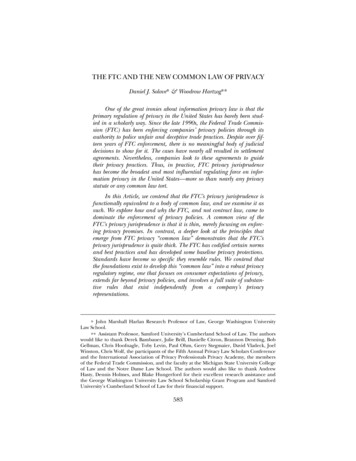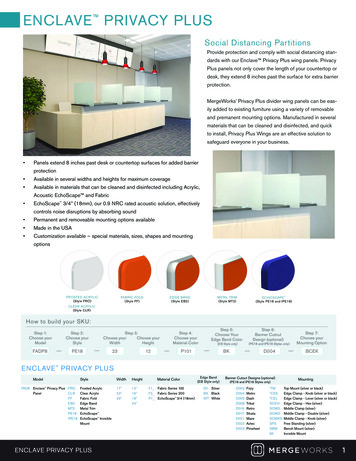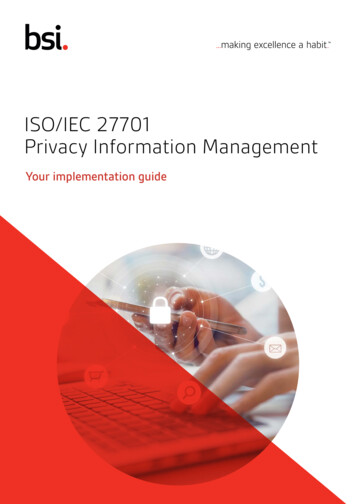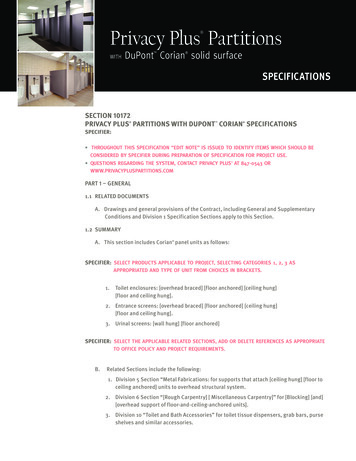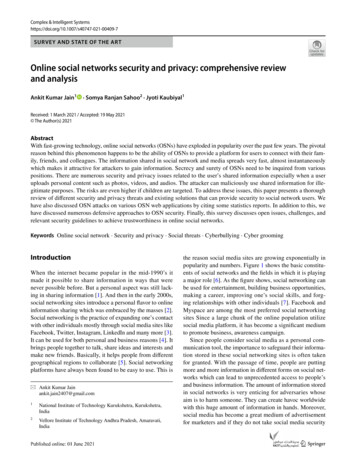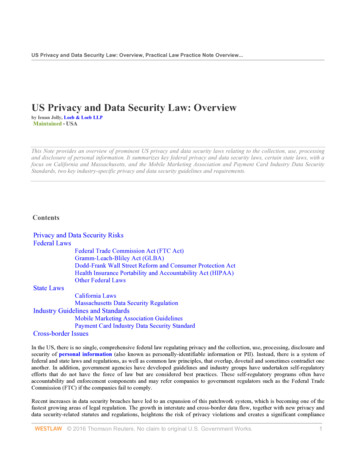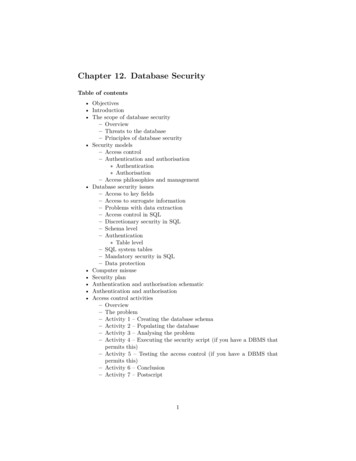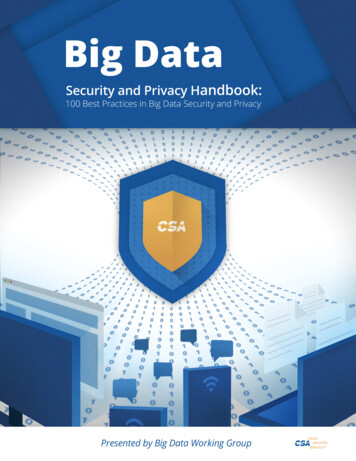
Transcription
The permanent and official location forCloud Security Alliance Big Data research / 2016 Cloud Security Alliance – All Rights Reserved All rights reserved.You may download, store, display on your computer, view, print, and link to Big Data Securityand Privacy Handbook: 100 Best Practices in Big Data Security and Privacy at a-handbook, subject to the following: (a) the Report maybe used solely for your personal, informational, non-commercial use; (b) the Report may notbe modified or altered in any way; (c) the Report may not be redistributed; and (d) the trademark, copyright or other notices may not be removed. You may quote portions of the Reportas permitted by the Fair Use provisions of the United States Copyright Act, provided that youattribute the portions to Big Data Security and Privacy Handbook: 100 Best Practices in BigData Security and Privacy.CLOUD SECURITY ALLIANCE Big Data Working Group Guidance Copyright 2016, Cloud Security Alliance. All rights reserved.2
Table of ContentsAcknowledgementsIntroduction1.0 Secure Computations in DistributedProgramming Frameworks1.1 Establish initial trust1.1.1 Why? 1.1.2 How?1.2 Ensure conformance with predefined security policies1.2.1 Why? 1.2.2 How?2.2 Safeguard data by dataencryption while at rest2.2.1 Why? 2.2.2 How?2.3 Use transport layer security(TLS) to establish connectionsand communication2.3.1 Why? 2.3.2 How?1.3 De-identify data1.3.1 Why? 1.3.2 How?2.4 Provide support for pluggableauthentication modules2.4.1 Why? 2.4.2 How?1.4 Authorize access to files withpredefined security policy1.4.1 Why? 1.4.2 How?2.5 Implement appropriate loggingmechanisms2.5.1 Why? 2.5.2 How?1.5 Ensure that untrusted code doesnot leak information via systemresources1.5.1 Why? 1.5.2 How?2.6 Apply fuzzing methods forsecurity testing2.6.1 Why? 2.6.2 How?1.6 Prevent information leakagethrough output1.6.1 Why? 1.6.2 How?1.7 Maintain worker nodes1.7.1 Why? 1.7.2 How?1.8 Detect fake nodes1.8.1 Why? 1.8.2 How?2.7 Ensure appropriate data-taggingtechniques2.7.1 Why? 2.7.2 How?2.8 Control communication acrosscluster2.8.1 Why? 2.8.2 How?1.10 Check for altered copies of data1.10.1 Why? 1.10.2 How?2.9 Ensure data replicationconsistency2.9.1 Why? 2.9.2 How?2.10 Utilize middleware layer forsecurity to encapsulate underlyingNoSQL stratum2.10.1 Why? 2.10.2 How?2.0 Security Best Practices for NonRelational Data Stores3.0 Secure Data Storage andTransactions Logs1.9 Protect mappers1.9.1 Why? 1.9.2 How?2.1 Protect passwords2.1.1 Why? 2.1.2 How?CLOUD SECURITY ALLIANCE Big Data Working Group Guidance Copyright 2016, Cloud Security Alliance. All rights reserved.3.1 Implement exchange of signedmessage digests3
Table of Contents (cont.)3.1.1 Why? 3.1.2 How?3.2 Ensure periodic audit ofchain hash or persistentauthenticated dictionary (PAD)3.2.1 Why? 3.2.2 How?3.3 Employ SUNDR3.3.1 Why? 3.3.2 How?3.4 Use broadcast encryption3.4.1 Why? 3.4.2 How?3.5 Apply lazy revocation and keyrotation3.5.1 Why? 3.5.2 How?3.6 Implement proof of retrievability(POR) or provable data possession(PDP) methods with high probability3.6.1 Why? 3.6.2 How?3.7 Utilize policy-based encryptionsystem (PBES)3.7.1 Why? 3.7.2 How?4.5 Secure the system against Sybilattacks4.5.1 Why? 4.5.2 How?4.6 Identify plausible ID spoofingattacks on the system4.6.1 Why? 4.6.2 How?4.7 Employ trusted devices4.7.1 Why? 4.7.2 How?4.8 Design parameter inspectors toexamine incoming parameters4.8.1 Why? 4.8.2 How?4.9 Incorporate tools to manageendpoint devices4.9.1 Why? 4.9.2 How?4.10 Use antivirus and malwareprotection systems at endpoints4.10.1 Why? 4.10.2 How?5.0 Real-Time Security/ComplianceMonitoring3.8 Implement mediated decryptionsystem3.8.1 Why? 3.8.2 How?5.1 Apply big data analytics to detectanomalous connections to cluster5.1.1 Why? 5.1.2 How?3.9 Use digital rights management3.9.1 Why? 3.9.2 How?5.2 Mine logging events5.2.1 Why? 5.2.2 How?3.10 Build secure cloud storage ontop of untrusted infrastructure3.10.1 Why? 3.10.2 How?4.0 Endpoint Input Validation/Filtering5.3 Implement front-end systems5.3.1 Why? 5.3.2 How?5.4 Consider cloud-level security5.4.1 Why? 5.4.2 How?4.1 Use trusted certificates4.1.1 Why? 4.1.2 How?5.5 Utilize cluster-level security5.5.1 Why? 5.5.2 How?4.2 Do resource testing4.2.1 Why? 4.2.2 How?5.6 Apply application-level security5.6.1 Why? 5.6.2 How?4.3 Use statistical similarity detectiontechniques and outlier detectiontechniques4.3.1 Why? 4.3.2 How?5.7 Adhere to laws and regulations5.7.1 Why? 5.7.2 How?4.4 Detect and filter malicious inputsat central collection system4.4.1 Why? 4.4.2 How?CLOUD SECURITY ALLIANCE Big Data Working Group Guidance Copyright 2016, Cloud Security Alliance. All rights reserved.5.8 Reflect on ethical considerations5.8.1 Why? 5.8.2 How?5.9 Monitor evasion attacks5.9.1 Why? 5.9.2 How?4
Table of Contents (cont.)5.10 Track data-poisoning attacks5.10.1 Why? 5.10.2 How?6.0 Scalable and Composable PrivacyPreserving Analytics6.1 Implement differential privacy6.1.1 Why? 6.1.2 How?6.2 Utilize homomorphic encryption6.2.1 Why? 6.2.2 How?6.3 Maintain software infrastructure6.3.1 Why? 6.3.2 How?6.4 Use separation of duty principle6.4.1 Why? 6.4.2 How?6.5 Be aware of re-identificationtechniques6.5.1 Why? 6.5.2 How?6.6 Incorporate awareness trainingwith focus on privacy regulations6.6.1 Why? 6.6.2 How?6.7 Use authorization mechanisms6.7.1 Why? 6.7.2 How?6.8 Encrypt data at rest6.8.1 Why? 6.8.2 How?6.9 Implement privacy-preservingdata composition6.9.1 Why? 6.9.2 How?6.10 Design and implement linkinganonymized datastores6.10.1 Why? 6.10.2 How?7.0 Cryptographic Technologies for BigData7.1 Construct system to search, filterfor encrypted data7.1.1 Why? 7.1.2 How?7.2 Secure outsourcing ofcomputation using fullyhomomorphic encryption7.2.1 Why? 7.2.2 How?7.3 Limit features of homomorphicCLOUD SECURITY ALLIANCE Big Data Working Group Guidance Copyright 2016, Cloud Security Alliance. All rights reserved.encryption for practicalimplementation7.3.1 Why? 7.3.2 How?7.4 Apply relational encryption toenable comparison of encrypted data7.4.1 Why? 7.4.2 How?7.5 Reconcile authentication andanonymity7.5.1 Why? 7.5.2 How?7.6 Implement identity-basedencryption7.6.1 Why? 7.6.2 How?7.7 Utilize attribute-based encryptionand access control7.7.1 Why? 7.7.2 How?7.8 Use oblivious RAM for privacypreservation7.8.1 Why? 7.8.2 How?7.9 Incorporate privacy-preservingpublic auditing7.9.1 Why? 7.9.2 How?7.10 Consider convergent encryptionfor deduplication7.10.1 Why? 7.10.2 How?8.0 Granular Access Control8.1 Choose appropriate level ofgranularity required8.1.1 Why? 8.1.2 How?8.2 Normalize mutable elements,denormalize immutable elements8.2.1 Why? 8.2.2 How?8.3 Track secrecy requirements8.3.1 Why? 8.3.2 How?8.4 Maintain access labels8.4.1 Why? 8.4.2 How?8.5 Track admin data8.5.1 Why? 8.5.2 How?8.6 Use standard single sign-on (SSO)mechanisms8.6.1 Why? 8.6.2 How?5
Table of Contents (cont.)8.7 Employ proper federation ofauthorization space8.7.1 Why? 8.7.2 How?8.8 Incorporate properimplementation of secrecyrequirements8.8.1 Why? 8.8.2 How?9.10 Create audit layer/orchestrator9.10.1 Why? 9.10.2 How?10.0 Data Provenance10.1 Develop infrastructureauthentication protocol10.1.1 Why? 10.1.2 How?8.9 Implement logical filter inapplication space8.9.1 Why? 8.9.2 How?10.2 Ensure accurate, periodic statusupdates10.2.1 Why? 10.2.2 How?8.10 Develop protocols for trackingaccess restrictions8.10.1 Why? 8.10.2 How?10.3 Verify data integrity10.3.1 Why? 10.3.2 How?9.0 Granular Audits9.1 Create a cohesive audit view ofan attack9.1.1 Why? 9.1.2 How?9.2 Evaluate completeness ofinformation9.2.1 Why? 9.2.2 How?10.4 Ensure consistency betweenprovenance and data10.4.1 Why? 10.4.2 How?10.5 Implement effective encryptionmethods10.5.1 Why? 10.5.2 How?10.6 Use access control10.6.1 Why? 10.6.2 How?9.3 Ensure timely access to auditinformation9.3.1 Why? 9.3.2 How?10.7 Satisfy data independentpersistence10.7.1 Why? 10.7.2 How?9.4 Maintain integrity of information9.4.1 Why? 9.4.2 How?10.8 Utilize dynamic fine-grainedaccess control10.8.1 Why? 10.8.2 How?9.5 Safeguard confidentiality ofinformation9.5.1 Why? 9.5.2 How?9.6 Implement access control andmonitoring for audit information9.6.1 Why? 9.6.2 How?9.7 Enable all required logging9.7.1 Why? 9.7.2 How?10.9 Implement scalable fine-grainedaccess control10.9.1 Why? 10.9.2 How?10.10 Establish flexible revocationmechanisms10.10.1 Why? 10.10.2 How?References9.8 Use tools for data collection andprocessing9.8.1 Why? 9.8.2 How?9.9 Separate big data and audit data9.9.1 Why? 9.9.2 How?CLOUD SECURITY ALLIANCE Big Data Working Group Guidance Copyright 2016, Cloud Security Alliance. All rights reserved.6
AcknowledgementsEditorsDaisuke MashimaSreeranga P. RajanContributorsAlvaro A. CárdenasYu ChenAdam FuchsWilco Van GinkelJanne HaldestenDan HiestandSrinivas JainiAdrian LaneRongxing LuPratyusa K. ManadhataJesus MolinaPraveen MurthyArnab RoyShiju SathyadevanP. Subra SubrahmanyamNeel SundaresanCSA Global StaffRyan BergsmaFrank GuancoJR SantosJohn YeohCLOUD SECURITY ALLIANCE Big Data Working Group Guidance Copyright 2016, Cloud Security Alliance. All rights reserved.7
IntroductionThe term “big data” refers to the massiveamounts of digital information companiesand governments collect about humanbeings and our environment. The amountof data generated is expected to doubleevery two years, from 2500 exabytes in 2012to 40,000 exabytes in 2020. Security andprivacy issues are magnified by the volume,variety, and velocity of big data. Large-scalecloud infrastructures, diversity of data sources and formats, the streaming nature of dataacquisition and high-volume, inter-cloudmigration all play a role in the creation ofunique security vulnerabilities.It is not merely the existence of largeamounts of data that creates new securitychallenges. In reality, big data has been collected and utilized for several decades. Thecurrent uses of big data are novel becauseorganizations of all sizes now have access tothe information and the means to employ it.In the past, big data was limited to very largeusers such as governments and more sizeable enterprises that could afford to createand own the infrastructure necessary forhosting and mining large amounts of information. These infrastructures were typicallyproprietary and isolated from general networks. Today, big data is cheaply and easilyaccessible to organizations large and smallthrough public cloud infrastructure. Software infrastructures such as Hadoop enabledevelopers to easily leverage thousands ofcomputing nodes to perform data-parallelcomputing. Combined with the ability to buycomputing power on-demand from publiccloud providers, such developments greatlyaccelerate the adoption of big data miningmethodologies. As a result, new securitychallenges have arisen from the couplingCLOUD SECURITY ALLIANCE Big Data Working Group Guidance Copyright 2016, Cloud Security Alliance. All rights reserved.of big data with public cloud environments,characterized by heterogeneous compositions of commodity hardware with commodity operating systems, as well as commoditysoftware infrastructures for storing andcomputing on data.As big data expands through streamingcloud technology, traditional security mechanisms tailored to secure small-scale, staticdata on firewalled and semi-isolated networks are inadequate. For example, analytics for anomaly detection would generatetoo many outliers. Similarly, it is unclearhow to retrofit provenance in existing cloudinfrastructures. Streaming data demandsultra-fast response times from security andprivacy solutions.This Cloud Security Alliance (CSA) documentlists out, in detail, the best practices thatshould be followed by big data service providers to fortify their infrastructures. In eachsection, CSA presents 10 considerations foreach of the top 10 major challenges in bigdata security and privacy. In total, this listing provides the reader with a roster of 100best practices. Each section is structured asfollows: What is the best practice? Why should it be followed? (i.e. whatis the security/privacy threat thwarted byfollowing the best practice?) How can the best practice beimplemented?This document is based on the risks andthreats outlined in the Expanded Top TenBig Data Security and Privacy Challenges.8
1.0 Secure Computations in DistributedProgramming FrameworksIn distributed programming frameworks such as Apache Hadoop, it is important to ensuretrustworthiness of mapper and secure data in spite of untrusted mappers. Also, it is necessaryto prevent information leakage from mapper output. Hence, the following guidelines shouldbe followed to ensure secure computations in distributed programming frameworks.1.1 Establish initial trust1.1.1 Why?To ensure trustworthiness of mappers.1.1.2 How?Establish initial trust by making master authenticate worker using Kerberos authenticationor equivalent when worker sends connection request to master. The authenticationshould be mutual to ensure authenticity of masters. Besides authentication, use of integritymeasurement mechanisms, i.e. one using Trusted Platform Module (TPM), should beconsidered.1.2 Ensure conformance with predefinedsecurity policies1.2.1 Why?To achieve a high level of security in computations.1.2.2 How?Periodically check security properties of each worker. For example, the master nodesHadoop-policy.xml should check for a match with the worker nodes security policy.CLOUD SECURITY ALLIANCE Big Data Working Group Guidance Copyright 2016, Cloud Security Alliance. All rights reserved.9
1.0 Secure Computations in Distributed Programming Frameworks (cont.)1.3 De-identify data1.3.1 Why?To prevent the identity of the data subject from being linked with external data. Such linkingmay compromise the subjects’ privacy.1.3.2 How?All personally identifiable information (PII), such as name, address, social security number,etc., must be either masked or removed from data. In addition to PII, attention should alsobe given to the presence of quasi-identifiers, which include data items that can almostuniquely identify a data subject (e.g., zip code, date of birth, and gender). Technologies suchas k-anonymity [Swe02] should be applied to reduce re-identification risks.1.4 Authorize access to files with predefined security policy1.4.1 Why?To ensure integrity of inputs to the mapper.1.4.2 How?Mandatory access control (MAC).1.5 Ensure that untrusted code does not leakinformation via system resources1.5.1 Why?To ensure privacy.1.5.2 How?Mandatory access control (MAC). Use Sentry for HBASE security using RBAC (role-basedaccess controls). In Apache Hadoop, the block access token is configured to ensure that onlyauthorized users are able to access the data blocks stored in data nodes.CLOUD SECURITY ALLIANCE Big Data Working Group Guidance Copyright 2016, Cloud Security Alliance. All rights reserved.10
1.0 Secure Computations in Distributed Programming Frameworks (cont.)1.6 Prevent information leakage through output1.6.1 Why?To ensure security and privacy. Data leakage may occur in many ways, which needs to be prevented(i.e. improper use of encryption). Debugging messages, uncontrolled output streams, loggingfunctions and detailed error pages help attackers learn about the system and formulate attack plans.1.6.2 How? Use function sensitivity to prevent information leakage. Shadow execution (i.e. communication towards external networks to obtain softwareversion updates) is another aspect that needs to be taken into consideration. Additionally, all data should be filtered on the network level (in-transit), in line with dataloss prevention policies. Sufficient de-identification of data also contributes to mitigation of the impact.1.7 Maintain worker nodes1.7.1 Why?To ensure proper functionality of worker nodes.1.7.2 How?Frequently check for malfunctioning worker nodes and repair them. Ensure they are configured correctly.1.8 Detect fake nodes1.8.1 Why?To avoid attacks in cloud and virtual environments.1.8.2 How?Build a framework to detect fake nodes introduced by creating snapshots of legitimate nodes.CLOUD SECURITY ALLIANCE Big Data Working Group Guidance Copyright 2016, Cloud Security Alliance. All rights reserved.11
1.0 Secure Computations in Distributed Programming Frameworks (cont.)1.9 Protect mappers1.9.1 Why?To avoid generating incorrect aggregate outputs.1.9.2 How?Detect the mappers returning wrong results due to malicious modifications.1.10 Check for altered copies of data1.10.1 Why?To avoid attacks in cloud and virtual environments.1.10.2 How?Detect for the data nodes that are re-introducing the altered copies and check such nodesfor their legitimacy. Hashing mechanism and cell timestamps of cell data will enforce integrity.CLOUD SECURITY ALLIANCE Big Data Working Group Guidance Copyright 2016, Cloud Security Alliance. All rights reserved.12
2.0 Security Best Practices for NonRelational Data StoresNon-relational data stores such as NoSQL databases typically have very few robust securityaspects embedded in them. Solutions to NoSQL injection attacks are not yet completelymature. With these limitations in mind, the following suggestions are the best techniques toincorporate while considering security aspects for non-relational data stores.2.1 Protect Passwords2.1.1 Why?To ensure privacy.2.1.2 How? By encryption or hashing using secure hashing algorithms. Use cryptographic hashing algorithms functions such as SHA2 (SHA-256 or higher) andSHA3. When hashing, use salt to counter offline, brute-force attacks.2.2 Safeguard data by data encryption while at rest2.2.1 Why?To reliably protect data in spite of weak authentication and authorization techniquesapplied.2.2.2 How?Use strong encryption methods such as the Advanced Encryption Standard (AES), RSA,and Secure Hash Algorithm 2 (SHA-256). The storage of code and encryption keys mustbe separate from the data storage or repository. The encryption keys should be backedup in an offline, secured location.CLOUD SECURITY ALLIANCE Big Data Working Group Guidance Copyright 2016, Cloud Security Alliance. All rights reserved.13
2.0 Security Best Practices for Non-Relational Data Stores (cont.)2.3 Use transport layer security (TLS) to establishconnections and communication2.3.1 Why?To maintain confidentiality while in transit; to establish trusted connections between theuser and server; and to securely establish communication across participating cluster nodes.2.3.2 How?Implement TLS/SSL (secure sockets layer) encapsulated connections. Ideally, each nodeis equipped with a unique public/private key pair and digital certificate so that clientauthentication is enabled.2.4 Provide support for pluggableauthentication modules2.4.1 Why?To certify users are able to program to pluggable authentication module (PAM) interface byusing PAM library API for authentication-related services.2.4.2 How?Implement support for PAM. Hardening with benchmarks established by the Center for InternetSecurity and hardening at the operating system (OS) level (e.g., SELinux) can be considered.2.5 Implement appropriate logging mechanisms2.5.1 Why?To expose possible attacks.2.5.2 How? Implement logging mechanisms according to industry standards, such as the NIST LogCLOUD SECURITY ALLIANCE Big Data Working Group Guidance Copyright 2016, Cloud Security Alliance. All rights reserved.14
2.0 Security Best Practices for Non-Relational Data Stores (cont.)Management Guide SP800-92 [KS06] and ISO27002 [ISO05]. Use advanced persistent threat (APT) logging mechanisms like log4j, etc. For example, ELKStack (Elasticsearch, Logstash, Kibana) and Splunk can be used for log monitoring and onthe-fly log analysis.2.6 Apply fuzzing methods for security testing2.6.1 Why?To expose possible vulnerabilities caused by insufficient input validation in NoSQL thatengages hypertext transfer protocol (HTTP) to establish communication with users (e.g.,cross-site scripting and injection).2.6.2 How? Provide invalid, unexpected or random inputs and test for them. Typical strategiesinclude dumb fuzzing, which uses completely random input, and smart fuzzing, whichcrafts input data based on knowledge about the input format, etc. Guidelines are provided by the Open Web Application Security Project (OWASP)(https://www.owasp.org/index.php/Fuzzing), MWR InfoSecurity inute-guide-to-fuzzing/), etc. Fuzzing shouldbe done at separate levels in a system, including the protocol level, data node level,application level, and so forth. Use tools for fuzzing, such as Sulley.2.7 Ensure appropriate data-tagging techniques2.7.1 Why?To avoid unauthorized modification of data while piping data from its source.2.7.2 How?Use security-tagging techniques that mark every tuple arriving on a specified data sourcewith a special, immutable security field including timestamp.CLOUD SECURITY ALLIANCE Big Data Working Group Guidance Copyright 2016, Cloud Security Alliance. All rights reserved.15
2.0 Security Best Practices for Non-Relational Data Stores (cont.)2.8 Control communication across cluster2.8.1 Why?To ensure a secure channel.2.8.2 How?Ensure each node validates the trust level of other participating nodes before establishing atrusted communication channel.2.9 Ensure data replication consistency2.9.1 Why?To handle node failures correctly.2.9.2 How?Use intelligent hashing algorithms and ensure that the replicated data is consistent acrossthe nodes, even during node failure.2.10 Utilize middleware layer for security to encapsulateunderlying NoSQL stratum2.10.1 Why?To have a virtual secure layer.2.10.2 How?By inducing object-level security at the collection, or column-level through the middleware,retaining its thin database layer.CLOUD SECURITY ALLIANCE Big Data Working Group Guidance Copyright 2016, Cloud Security Alliance. All rights reserved.16
3.0 Secure Data Storage andTransactions LogsSecurity is needed in big data storage management because solutions, such as auto tiering,do not record the storage place of data. The following practices should be implemented toavoid security threats.3.1 Implement exchange of signed message digests3.1.1 Why?To address potential disputes.3.1.2 How? Use common message digests (SHA-2 or stronger) to provide digital identifier for eachdigital file or document, which is then digitally signed by the sender for non-repudiation. Use the same message digest for identical documents. Use distinct message digests even if the document is partially altered.3.2 Ensure periodic audit of chain hash or persistentauthenticated dictionary (PAD)3.2.1 Why?To solve user freshness and update serializability issues.3.2.2 How?Use techniques such as red-black tree and skip lists data structures to implement PAD[AGT01].CLOUD SECURITY ALLIANCE Big Data Working Group Guidance Copyright 2016, Cloud Security Alliance. All rights reserved.17
3.0 Secure Data Storage and Transactions Logs (cont.)3.3 Employ SUNDR3.3.1 Why?To store data securely on untrusted servers3.3.2 How?Use SUNDR (secure untrusted data repository) to detect any attempts at unauthorized filemodification by malicious server operators or users. It is also effective to detect integrity orconsistency failures in visible file modifications using fork consistency.3.4 Use broadcast encryption3.4.1 Why?To improve scalability.3.4.2 How?Use broadcast encryption scheme [FN 93] in which a broadcaster encrypts a messagefor some subset S of users who are listening on a broadcast channel. Any user in Scan use a private key to decrypt the broadcast. However, even if all users outside ofS collude, they can obtain no information about the content of the broadcast. Suchsystems are said to be collusion resistant. The broadcaster can encrypt to any subset Sof his choice. It may still be possible that some members of S may contribute to piracyby constructing a pirate decoder using private keys assigned to them. To ascertain theidentities of such malicious members—and thereby discourage piracy—traitor-tracingmechanisms should be implemented as well.CLOUD SECURITY ALLIANCE Big Data Working Group Guidance Copyright 2016, Cloud Security Alliance. All rights reserved.18
3.0 Secure Data Storage and Transactions Logs (cont.)3.5 Apply lazy revocation and key rotation3.5.1 Why?To improve scalability.3.5.2 How? Use lazy revocation (i.e. delay re-encryption until a file is updated in order to makerevocation operation less expensive). To implement lazy revocation, generate a new filegroup for all the files that are modifiedfollowing a revocation and then move files to this new filegroup as files get re-encrypted.This process raises two issues, as stated below:Issue: There is an increase in the number of keys in the system following eachrevocation.Solution: Relate the keys of the filegroups that are involved.Issue: Because file sets that are re-encrypted following successive revocations arenot really contained within each other, it becomes increasingly difficult to determinewhich filegroup a file should be assigned to when it is re-encrypted.Solution: Use key rotation. Set up the keys so that files are always (re)encrypted withthe keys of the latest filegroup. This ensures that users are required to remember onlythe latest keys and derive previous ones when necessary.3.6 Implement proof of retrievability (POR) or provabledata possession (PDP) methods with high probability3.6.1 Why?To enable a user to reliably verify that data uploaded to the cloud is actually available andintact, without requiring expensive communication overhead3.6.2 How?Ateniese et al. [ABC 07] introduced a model for provable data possession (PDP) that allows auser that has stored data at an untrusted server to verify that the server possesses the originaldata without retrieving it. The model generates probabilistic proof of possession by samplingrandom sets of blocks from the server, which drastically increases efficiency. The usermaintains a constant amount of metadata to verify the proof. The challenge/response protocoltransmits a small, constant amount of data, which minimizes network communication.CLOUD SECURITY ALLIANCE Big Data Working Group Guidance Copyright 2016, Cloud Security Alliance. All rights reserved.19
3.0 Secure Data Storage and Transactions Logs (cont.)Kaliski and Juels [JK07] developed a somewhat different cryptographic building block knownas a proof of retrievability (POR). A POR enables a user to determine whether it can “retrieve”a file from the cloud. More precisely, a successfully executed POR assures a verifier that theprover presents a protocol interface through which the verifier can retrieve the given file in itsentirety. Of course, a prover can refuse to release the file even after successfully participatingin a POR. A POR, however, provides the strongest possible assurance of file retrievabilitybarring changes in prover behavior.3.7 Utilize policy-based encryption system (PBES7)3.7.1 Why?To avoid collusion attacks (assuming users do not exchange their private keys).3.7.2 How? Allow user to encrypt a message with respect to a credential-based policy formalized asmonotone Boolean expression written in standard, normal form. Provide encryption so that only a user having access to a qualified set of credentials for thepolicy is able to successfully decrypt the message.3.8 Implement mediated decryption system3.8.1 Why?To avoid collusion attacks (assuming users are willing to exchange private keys withoutexchanging decrypted content).3.8.2 How?A mediated RSA cryptographic method and system is provided in which a sender encryptsa message (m) using an encryption exponent e and a public modulus n, and a recipient anda trusted authority cooperate with each other to decrypt the encrypted message by usingrespective components dU, dT of a decryption exponent. In order to prevent the trustedauthority from reading the message in the event that it has access to the recipient decryptionexponent components dU, the recipient blinds the encrypted message before passing it tothe trusted authority. This blinding is affected by a modulo-n blinding operation using a factorr e where r is a secret random number. The trusted authority then applies its decryptionexponent component dT to the message and returns the result to the recipient who cancelsthe blinding and applies its decryption exponent component dU to recover the message.CLOUD SECURITY ALLIANCE Big Data Working Group Guidance Copyright 2016, Cloud Security Alliance. All rights reserved.20
3.0 Secure Data Storage and Transactions Logs (cont.)3.9 Use digital rights management3.9.1 Why?To counter collusion attacks where users are willing to exchange decrypted contentswhen access control is implemented by means of encryption3.9.2 How?Digital rights management (DRM) schemes are various access control technologiesthat are used to restrict usage of copyrighted works. Such a scheme is also effectiveto control access to protected data in a distributed system environment. To preventunauthorized access to protected information, some frameworks restrict optionsfor accessing content. For instance, the protected content can only be opened on aspecific device or with particular viewer software, where access rights and/or policiesare securely enforced (perhaps at the hardware level). Moreover, the integrity of suchsoftware or devices can be attested by a cloud storage provider, etc., by means ofremote attestation techniques and/or TPM (Trusted Platform Module) when necessary.3.10 Build secure cloud storage on top ofuntrusted infrastructure3.10.1 Why?To store information in a confidential, integrity-protected way—even with untrusted
5.0 Real-Time Security/Compliance Monitoring 5.1 Apply big data analytics to detect anomalous connections to cluster 5.1.1 Why? 5.1.2 How? 5.2 Mine logging events 5.2.1 Why? 5.2.2 How? 5.3 Implement front-end systems 5.3.1 Why? 5.3.2 How? 5.4 Consider cloud-level security 5.4.1 Why? 5.4.2
